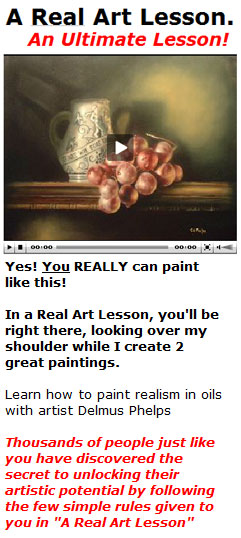Oil Painting Lesson Step 5
Posted by admin | Under Oil Painting Saturday Apr 24, 2010To start the lesson follow the steps below:
Read Introduction on Landscape Oil Paintings
Follow Oil Painting Lesson Step 1
Follow Oil Painting Lesson Step 2
Follow Oil Painting Lesson Step 3
Follow Oil Painting Lesson Step 4
Follow Oil Painting Lesson Step 5
Follow Oil Painting Lesson Step 6
Step 5
For the fifth step-finishing off the treetops – fold the paper until you can hold it firmly. Again, dip just the tips of the paper in the paint on your palette. Choose light colors. Our most important consideration is that we want to create a representation of leaves, but don’t just rely on green. Light red will accomplish the same thing. We’ll really see what light can accomplish when you let it dance to its heart’s content. Light will illuminate and exalt even a portrait. How much more will it do when your subject is an organic miracle of nature that lives and dies with the sun! So put on l a little red with your green or pale blue. By the time you’re done, the tops of your trees can be crazy quilts of color, a lovely swirling hubbub of leaf and sunshine with tiny patches of sky peeking through. The novice just paints an object, dull and alone, but a good artist paints it in the full complexity of its relationship to the forces around it. He knows that when you look at a leaf, a good percentage of what you actually see are other elements that are forever playing upon it.
There you are in front of your easel with a wad of toilet paper dipped in light, spangly colors. Now press the paper gently against the canvas so that you cover the upper limbs of each tree. For all intents and purposes, the relatively large circles of thin bright paint that you create this way will complete the essential part of your landscape painting.
Using the same sort of easy wrist movement, drag another wad of toilet paper, also dipped in light colors, against your sky. The more interesting the color scheme, the more vibrant and convincing will be your background.
Again, I would advise that you spend a few moments I looking at the sky. Study its dynamism. The clouds pour I into the blue, while streaks of color from God-knows-where stretch across the horizon. So for goodness’ sake don’t hesitate to be creative with your color scheme. You’ll surprise yourself with just how new and delightful an unexpected burst of orange or pink can be. Naturally, not all your dabs of color will be equally pleasing. Often you’ll be disappointed by a blue that’s too pasty or a yellow that’s too deep. It’s a lot like cooking. Even the best chef puts in too much paprika once in a while. Fortunately you don’t have to eat your art, so the situation is considerably less critical.
